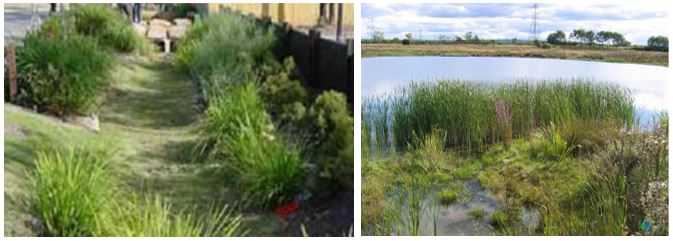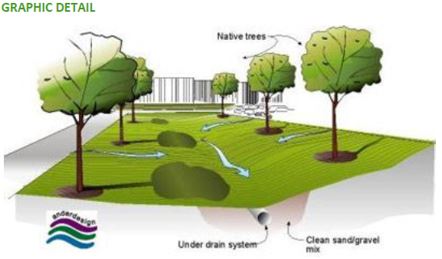Swales are shallow, flat bottomed, vegetated open channels designed to convey, treatand often attenuate surface water runoff. When incorporated into site design, they can enhance the natural landscape and provide aesthetic and biodiversity benefits. They are often used to drain roads, paths or car parks, where it is convenient to collect distributed in flows of runoff, or as a means of conveying runoff on the surface while enhancing access corridors or other open space. Swales can have a variety of profiles, can be uniform or non-uniform, and can incorporate a range of different planting strategies, depending upon the site characteristics and system objectives.

Grassed swales have the capability to reduce runoff volume and improve water quality. Volume reduction occurs primarily through infiltration into the soil, either as the waterflows over the slide slope perpendicular to the roadway into the swale or down thelength of the swale parallel to the roadway. Pollutant removal can occur by sedimentation of solid particles onto the soil surface, filtration of solid particles by vegetation, or infiltration of dissolved pollutants (with stormwater) into the soil (Abidaand Sabourin, 2006). When solid particles settle to the soil surface or are captured byfiltration on vegetation, the total suspended solids concentration of the runoff is reduced and overall water quality is improved as long as the solids do not become resuspended.

Retention ponds are ponds or pools designed with additional storage capacity to attenuate surface runoff during rainfall events. They consist of a permanent pond area with landscaped banks and surroundings to provide additional storage capacity during rainfall events. They are created by using an existing natural depression, by excavating a new depression, or by constructing embankments.
Retention ponds can provide both storm water attenuation and water quality treatment by providing additional storage capacity to retain runoff and release this at a controlled rate. Retention ponds have good capacity to remove urban pollutants and improve the quality of surface runoff.
Comments ()